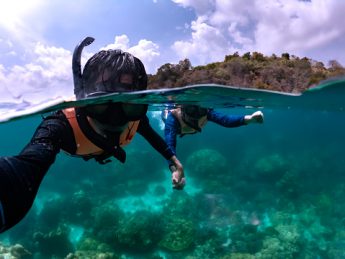Introduction
Quick Navigation
The importance of having a dive buddy cannot be overemphasized. You need a fellow diver to help you keep track of your activity so that there is someone to get you through it if anything goes wrong underwater. Besides, it is the safest way to call for help.
However, there are situations where you or your dive buddy could get carried away and lose sight of each other. Being in this scenario could be scary, but there are things you could do. Hence, this article aims to provide you with instructions to follow if you ever separate from your dive buddy.
What are the Factors That Could Get You Separated from Your Dive Buddy?
The buddy system is a basic rule of diving because you need assistance from someone going through a similar situation as you. With a fellow diver, you have less chance of scuba accidents or injuries. It doesn’t matter how experienced you are; having one close to you is important.
However, some factors could be responsible for separating you from your buddy. They are distractions, poor underwater visibility, water currents, equipment malfunction, and miscommunication. If you lose your dive buddy to any of these factors, it could be in danger, which is why you need to stop panicking and go for what’s next.
What are the 7 Instructions You Need to Follow?
Following the instructions below will help you reunite with a fellow scuba diver underwater at the surface.
Stop Diving
The moment you realize that you’ve lost your dive buddy, you shouldn’t ever make the mistake of trying to find the person – in fact, all movement should stop. Trying to find the person only makes things worse and almost impossible to reunite with them.
Once you stop diving, you are left with doing what’s next – maintaining an upright position with neutral buoyancy. That marks your stop, so you don’t go further and make things more complicated than it already is.
Turn 360 degrees at a Slow Pace
By maintaining an upright position, you can turn 360 degrees without losing where you are. However, you need to do this slowly so that you don’t go further and totally lose sight of where you are – everything is now disrupted, which means the dive plan isn’t going accordingly anymore.
When you turn 360 degrees at a slow pace, ensure to check upwards and downwards to know if your dive buddy descended or ascended. Besides, your position gives you a great chance at finding things easily – for instance, air bubbles show a sign of life. If you see air bubbles, your partner is probably in that direction.
Get Signaling Tools
Getting lost underwater is common, which is why it is always advisable to go with signaling tools. The reason for having this tool is so that you can draw attention to yourself. It might help your buddy spot you, or vice versa.
The best signal tools are light and sound. However, these signals must be known to you and your buddy so that the other person can easily understand them.
See why you need a strobe dive light here.
Slowly Begin Ascension
If you cannot still find your dive buddy, even with the signal tools, you should proceed to ascend back to the surface. There is a higher chance of meeting the person at the surface than below, anyway. While you are about to ascend, you should take precautions, so you don’t use up all your energy or consume a lot of gas.
The time between finding your buddy and ascension should be a maximum of 1 minute. After 1 minute, begin regular ascension, and stop after another 1-minute to check for signals, i.e., light or sound. Repeat the process until you reach the surface.
Maximize Ascension Line
Just when you are planning to go back to the surface, ensure to take another precaution, i.e., maximizing the use of the ascension line. Poor visibility is a thing underwater – a significant cause of buddy separation. However, having an ascension line or SMB will help you get through the situation without panicking. It is a visual marker that will notify anyone at the surface that you are about to come back.
In essence, an ascension line or SMB gets you the help you need at the surface. It also notifies the other diver that you are almost at the surface – if he already is.
Stay at the Surface
The second to the last thing you should do is to stay at the surface to look out for your partner. Take a 360-degree turn as you did underwater and look for signs, i.e., air bubbles. This time, you can stay more than a minute at the surface since there is nothing to limit your breathing.
If you cannot find air bubbles, the next thing is to get on a boat and call for rescue that there is an emergency.
Do Not Go Underwater Again
Not, in any case, should you go underwater after spending time at the surface. As a matter of fact, one of the proactive measures you need to take with your dive buddy is to plan maximum time to wait or meet at the surface before calling for rescue.
If your dive buddy exceeds that time, you should not go underwater again to look for him. There is a likely chance that you would also get lost. Besides, there is no dive plan, making it dangerous. So, for your safety, head to a dive boat or center and call for professional rescue to help you get your buddy back to the surface.
Conclusion
Buddy separation is somewhat inevitable – no matter how experienced you think you are, you could be in that position. However, learning what to do if you ever find yourself in this situation is what is paramount. Luckily, this guide has provided instructions on what to do; you must follow them strictly for a safe diving experience.

